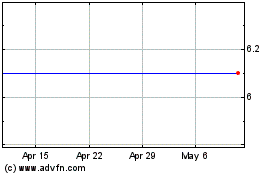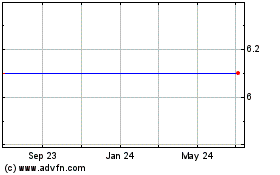Santander's Profit Slips on Currency Turbulence -- 3rd Update
April 27 2016 - 6:26AM
Dow Jones News
By Jeannette Neumann
MADRID-- Banco Santander SA on Wednesday reported a 5% decline
in first-quarter net profit on weaker lending and fee income as
currency turmoil from the U.K. to recession-hit Brazil squeezed
profits.
Net profit fell to EUR1.63 billion ($1.84 billion), while net
interest income--the difference between what lenders pay clients
for deposits and charge for loans--was EUR7.62 billion, compared
with EUR8.04 billion in the first quarter of 2015.
Both net profit and net interest income were roughly in line
with analyst expectations, according to a poll by data provider
FactSet. Santander shares were up around 2% around noon trading in
Madrid.
"We continue to deliver on all our commitments," Executive
Chairman Ana Botín said in a statement, including an uptick in the
bank's closely watched capital ratio.
The decline in net profit, the bank said, was triggered by the
depreciation of various currencies against the euro. A drop in the
value of the Brazilian and Mexican currencies, for instance,
chipped away at Santander's earnings, which are reported in
euros.
Currency volatility in the bank's Latin American units is
nothing new for Santander.
What isn't as common for the bank is notable turmoil in the
British pound against the euro.
The currency has fallen against the euro since the beginning of
the year as investors weigh the possibility that U.K. voters cast
their ballots in favor of an exit from the European Union, known as
"Brexit."
The pound, however, has rallied in recent days. Further market
moves could come ahead of the June 23 vote, analysts say.
Santander has a major bank in the U.K., which Ms. Botín ran
before taking the helm of the eurozone's largest lender by market
value.
Santander said net profit was roughly flat in the U.K. in the
first quarter compared with a year earlier when accounted for in
sterling, while it fell around 4% when accounted for in euros.
In Brazil, despite a recession and political upheaval, loan loss
provisions in the first quarter of this year fell from the fourth
quarter of last year when measured in the local currency.
"The lack of a deterioration in Brazil and good capital
generation should be supportive of performance in the short term,"
Keefe, Bruyette & Woods analyst Daragh Quinn wrote in a
research report. "Longer term, given the uncertainties in the
outlook for Brazil, we continue to remain relatively cautious on
Santander," he added.
Still, the exact performance of Santander's units can be
difficult to parse, given the losses the bank reports in what is
called its corporate center, a vaguely defined area set up as a
catchall category for shared costs like headquarters staff.
Santander booked EUR311 million of losses in the corporate
center in the first quarter of this year.
Ms. Botín has said she is working to ensure that investors and
analysts have a clear understanding of what charges or gains are
included in the corporate center.
Overall, fees at Santander fell 5% from a year earlier to EUR2.4
billion. They were also down compared with the fourth quarter.
Santander reported a capital ratio of 10.27% as of March 31,
under international regulations known as "fully loaded" Basel III
criteria. The bank said it was on track for its capital ratio to
exceed 11% in 2018.
Investors and analysts have been keeping a close eye on the pace
at which Santander is able to generate capital. The lender's
financial cushion remains below that of its European banking
peers.
Santander's ratio of bad loans to total loans fell slightly to
4.33% in the first quarter of this year. Provisions for bad loans
also fell.
Write to Jeannette Neumann at jeannette.neumann@wsj.com
(END) Dow Jones Newswires
April 27, 2016 06:11 ET (10:11 GMT)
Copyright (c) 2016 Dow Jones & Company, Inc.
Banco Santander (NYSE:STD)
Historical Stock Chart
From Mar 2024 to Apr 2024

Banco Santander (NYSE:STD)
Historical Stock Chart
From Apr 2023 to Apr 2024
